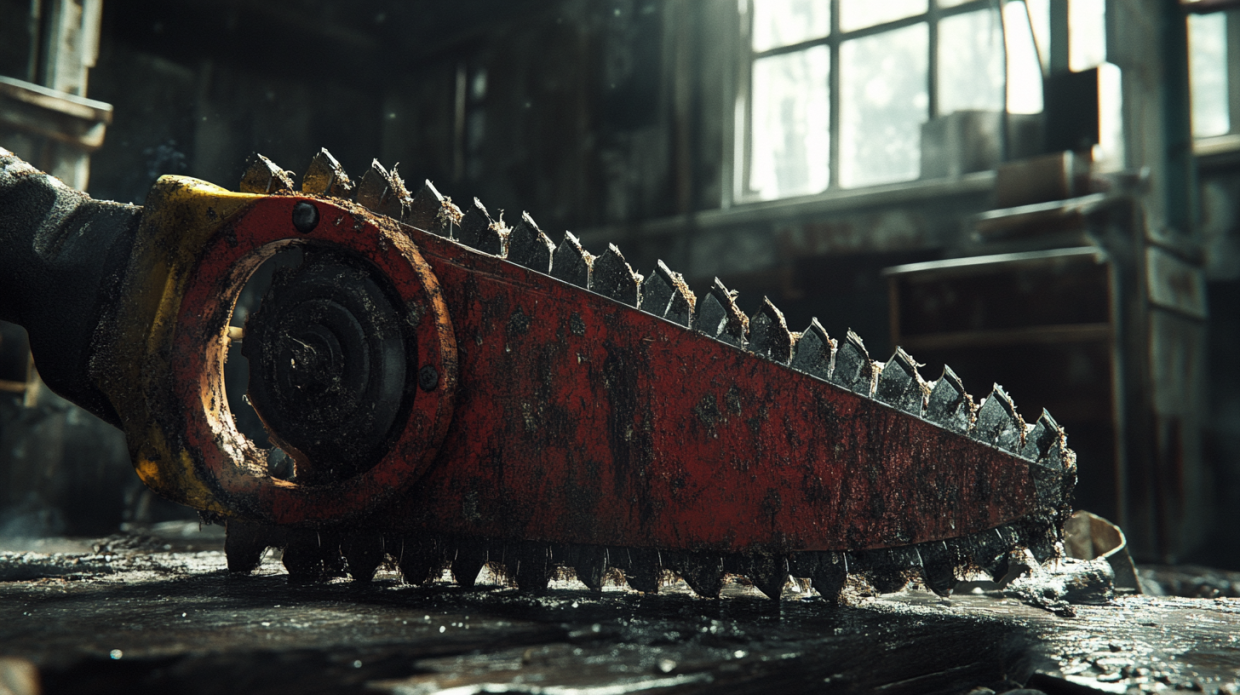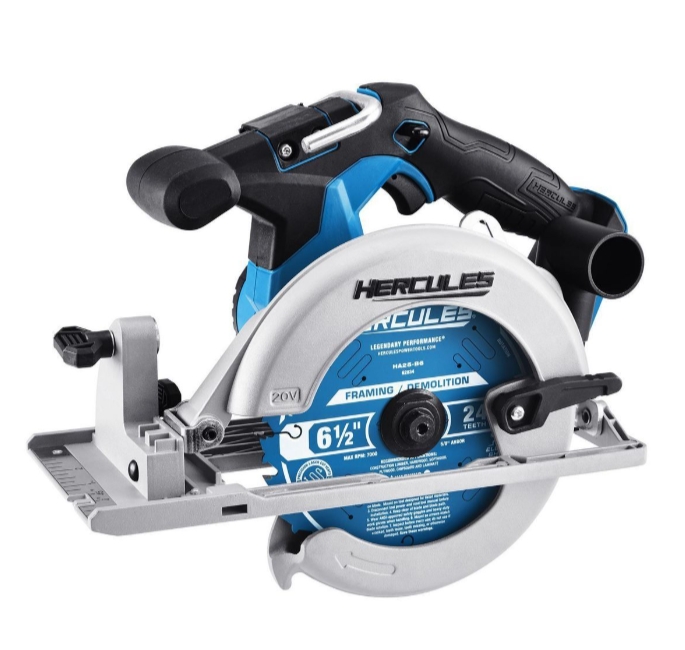
HERCULES 20V Cordless 6-1/2 in. Circular Saw – Tool Only
- This powerful HERCULES® cordless circular saw cuts 25% faster and delivers 3x more runtime*. The high efficiency 5000 RPM motor with soft start and all metal gear construction provides smooth powerful cuts for a variety of tough materials.
- High power cutting performance for the toughest jobs
- Precision lightweight aluminum shoe with easy-to-read markings for accurate cuts
- LED light for maximum cut line visibility in low light situations
- Soft start and electric brake provide maximum operator control
- Integrated rafter hook for easy storage between uses
- Blade guard with attachable dust port designed to easily connect to common dust collectors
$59.99
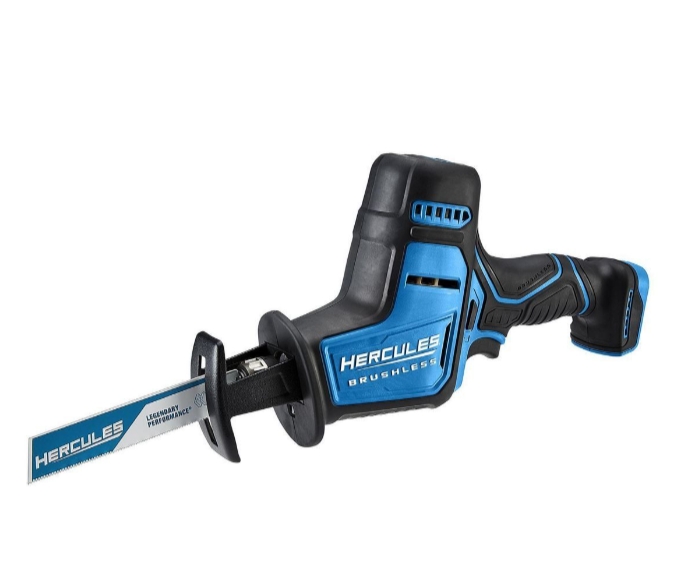
HERCULES 12V Brushless Cordless Compact Reciprocating Saw – Tool Only
- The HERCULES® 12V Brushless Cordless Compact Reciprocating Saw is 30% more compact, 48% lighter* for easy one-handed use. This reciprocating saw cuts faster than corded and uses brushless technology for longer tool life, extended runtime and up to 3000 SPM for fast cutting. The curved shoe provides control in a variety of cutting positions. The chuck is designed for quick, keyless blade changes.
- Brushless motor for up to 45% longer runtime and more power
- Electronic soft start for smooth startups and longer tool life
- Tool-free blade change system for fast blade changes between cuts
- Ergonomic rubberized grip for reduced vibration and fatigue
- Built-in LED work light for a clear view of the cutting area
- Electric brake for quick switching between cuts
$59.99
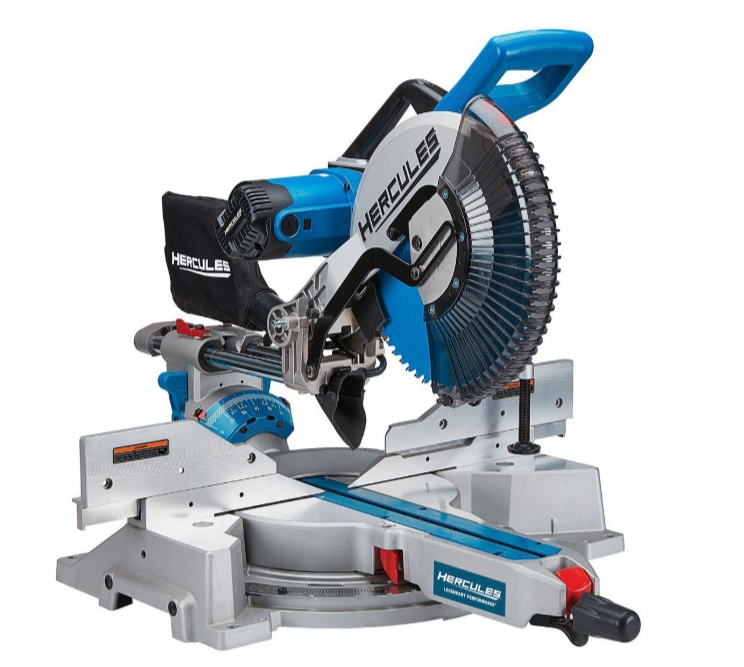
HERCULES 12 in. Dual-Bevel Sliding Compound Miter Saw with Precision LED Shadow Guide
- The HERCULES® Professional 12 in. Dual Bevel Sliding Miter Saw was engineered to deliver Legendary Performance in your shop or on the jobsite. Designed with the same cutting capacity, precision, accuracy, and durability as the best-selling professional miter saws on the market. The HERCULES® Miter Saw is packed with features for the professional at an unbeatable price.
- 7-1/2 in. crown molding nested capacity
- 6-3/4 in. baseboard vertical capacity
- Precision Blade Guide System allows better visibility of cut line for accurate cuts every time
- High-output 15 amp, 4100 RPM motor delivers the power needed for high-performance cutting
- Adjustable stainless steel miter detent plate with 10 positive stops
- Miter detent override system for fine adjustments
- Double-bevel design with oversized bevel scale makes bevel-angle adjustments accurate and easy
- Miters 60° to the right and 50° to the left to accommodate a wide variety of cuts
- Free professional 60-tooth carbide-tipped saw blade included
$349.99
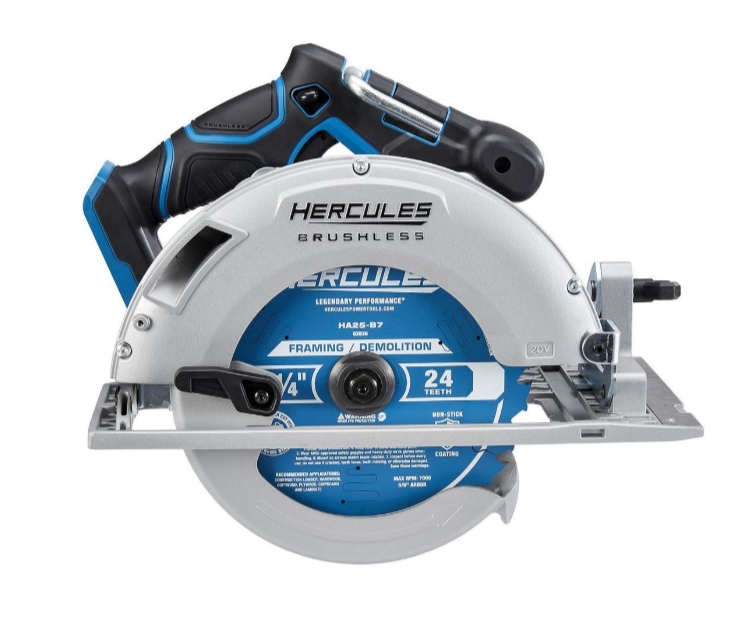
HERCULES 20V Brushless Cordless 7-1/4 in. Circular Saw – Tool Only
- The HERCULES® 20v Brushless Cordless 7-1/4 in. Circular Saw features an advanced brushless motor for up to 45% more run-time*. With 2-1/2 in. max cutting depth this saw handles a wide variety of framing jobs. The sturdy magnesium footplate has a precision scale for accurate bevel cuts from 0-50°. The integrated rafter hook makes it easy to store the tool between jobs. Combined with the HERCULES® lithium battery system for fast charging and longer runtime, this tool delivers legendary performance that professionals demand.
- Brushless motor technology boosts efficiency, generates more power in a compact size
- 5000 RPM high power brushless performance for the toughest jobs
- LED light for maximum cut line visibility in low light situations
- Precision lightweight magnesium shoe with easy-to-read markings for accurate cuts
- Soft start and electric brake provide maximum operator control
- Lightweight magnesium blade guard with attachable dust port for easy connection to most dust collectors
- Integrated rafter hook for easy storage
$99.99
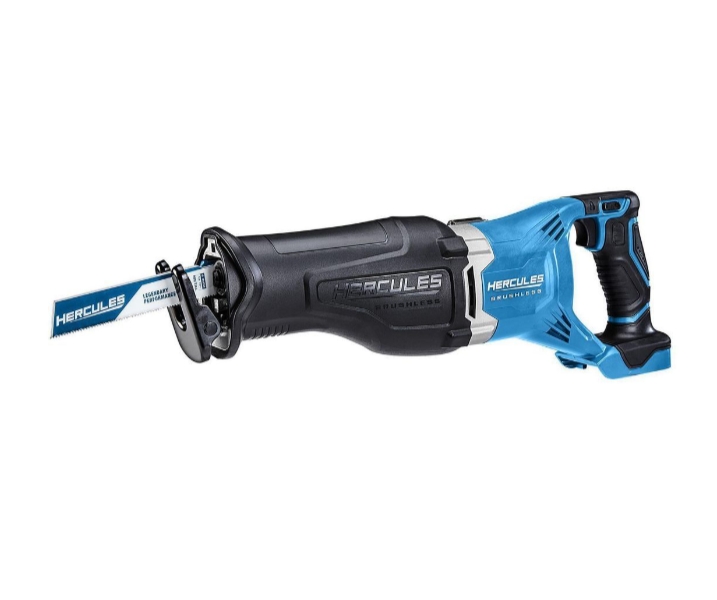
HERCULES 20V Brushless Cordless Reciprocating Saw – Tool Only
- The HERCULES® 20V Brushless Cordless Reciprocating Saw cuts faster than corded and uses brushless technology for up to 45% more runtime*. A pivoting shoe with 3 position depth adjustment provides ultimate cutting control in a wide variety of materials. The keyless single-action quick-change blade mechanism cuts downtime on the job. Integrated electric brake quickly stops the blade when the trigger is released, making it easier to move from one cut to the next. This saw comes with a HERCULES® professional 6 in. 14TPI saw blade.
- High performance motor and variable speed trigger delivers up to 3000 SPM for faster cuts in high demand applications
- Anti-vibration design reduces user fatigue during prolonged use
- All-metal gearing and gear case construction provides maximum durability
- Pivoting adjustable shoe and variable speed trigger for depth of cut control
- Keyless, single action quick blade change allows user to efficiently switch blades
- Bright LED light to illuminate dark work areas
- Rubber over-molded grip for user comfort and rubberized housing to protect the tool
- Electric brake allows user to quickly move from one cut to another
- Integrated hang hook for convenient storage on the job
- Compatible with all HERCULES® 20V batteries
$74.99
When I first stepped into the world of power tools, I was overwhelmed. The endless options, technical specifications, and varying price points left me paralyzed with indecision. That was before I discovered Hercules saws—a game-changer for both my workshop and wallet. After years of personal experience and countless projects later, I’m sharing everything I’ve learned about these powerful yet affordable tools.
If you’re in the market for a quality saw that delivers professional results without the premium price tag, you’ve come to the right place. The right Hercules saw can transform your woodworking experience from frustrating to fulfilling while maintaining your budget intact.
The Hercules Lineup: Understanding Your Options
The Hercules tool line has gained significant traction in recent years, and for good reason. Their saw selection covers virtually every cutting need you might encounter, whether you’re a weekend warrior or a daily contractor.
Circular Saws: The Workshop Staple
My first Hercules purchase was their 7-1/4″ circular saw, and it remains one of my most used tools. The Hercules circular saw lineup includes:
- 7-1/4″ sidewinder circular saw (corded)
- 7-1/4″ brushless circular saw (cordless)
- 6-1/2″ compact circular saw (cordless)
What impressed me immediately was the robust build quality. The machined aluminum base provides exceptional stability during cuts, something I’ve found lacking in other budget-friendly options. The depth adjustment lever feels solid rather than flimsy, and the bevel capacity goes up to 56 degrees—perfect for those tricky angled cuts on crown molding projects.
The corded model delivers 15 amps of power, putting it on par with much more expensive brands. When I’m ripping through 2x4s or cutting sheet goods, it never bogs down, maintaining a smooth 5,500 RPM that makes quick work of dimensional lumber.
For those preferring cordless flexibility, the brushless models in the 20V lineup provide surprisingly comparable power. I’ve found the runtime excellent, easily handling an entire day of moderate cutting on a single battery charge.
Reciprocating Saws: Demolition Made Easy
When I undertook a kitchen renovation last summer, the Hercules reciprocating saw became my constant companion. The line includes:
- 12-amp corded reciprocating saw
- 20V brushless reciprocating saw (standard)
- 20V compact reciprocating saw
The 1-1/8″ stroke length provides aggressive cutting action that made removing old cabinets and cutting through nail-embedded studs a breeze. What really stands out is the variable speed trigger (0-3,000 SPM) that allows for precision control—essential when cutting near plumbing or electrical work.
The tool-free blade change system is a lifesaver when switching between wood, metal, and demolition blades. No more hunting for that special wrench that always seems to disappear!
Miter Saws: Precision Personified
For trim work and framing, nothing beats a quality miter saw. Hercules offers:
- 12″ dual-bevel sliding compound miter saw
- 10″ single-bevel compound miter saw
- 7-1/4″ single-bevel sliding miter saw
I invested in the 12″ dual-bevel model for a major deck project, and the crosscutting capacity of 2×14 at 90 degrees was invaluable for the wide decking boards. The LED cut line indicator eliminates guesswork, ensuring precision cuts every time.
The detents at common angles (0, 15, 22.5, 31.6, and 45 degrees) engage with a satisfying click, and the miter scale is etched rather than printed—no worrying about labels wearing off over time.
Table Saws: Workshop Centerpiece
For serious woodworking, Hercules offers:
- 10″ jobsite table saw with stand
- 8-1/4″ portable table saw
The 10″ model has become the heart of my workshop. With a 15-amp motor delivering 4,500 RPM and a 24″ rip capacity, it handles everything from sheet goods to hardwoods. The rack-and-pinion fence system maintains perfect alignment, something I’ve struggled with on other saws in this price range.
Specialty Saws: Task-Specific Solutions
Beyond the standard offerings, Hercules also provides:
- 20V jigsaw (cordless)
- 4-1/2″ angle grinder (can be used with cutting wheels)
- 20V multi-tool (ideal for flush cutting and plunge cuts)
The jigsaw has become my go-to for curved cuts and interior cutouts. With orbital action settings and a tool-free blade change system, switching between rough cutting and fine finishing is effortless.
Where to Find These Workshop Heroes
If you’re looking to get your hands on Hercules tools, there’s primarily one destination: Harbor Freight. As the exclusive retailer for the Hercules line, all their saws are available both in-store and online at harborfreight.com.
This exclusivity has its advantages. I’ve found that the in-store staff at Harbor Freight are typically well-versed in the Hercules line and can provide hands-on demonstrations. Many locations have display models that you can handle before purchasing—something I consider essential when investing in a power tool.
Harbor Freight has over 1,100 stores nationwide, making it likely there’s one within reasonable driving distance. When I purchased my table saw, being able to see it assembled and test the fence mechanism in person sealed the deal for me.
The company regularly runs promotions on Hercules tools, particularly around major holidays. I scored my miter saw during a Memorial Day sale at a significant discount. Signing up for their Inside Track Club membership has also netted me exclusive coupons and early access to sales.
Price Points: Value Without Compromise
One of the most compelling aspects of the Hercules line is their pricing strategy. While positioned as Harbor Freight’s premium tool line, they still offer considerable savings compared to the “big name” brands.
From my experience, here’s what you can expect to pay (prices may vary):
- Circular Saws: $89-$159 (corded models on the lower end, brushless cordless on the higher)
- Reciprocating Saws: $79-$129
- Miter Saws: $199-$399 (with the 12″ dual-bevel sliding model at the top end)
- Table Saws: $299-$499 (the 10″ with stand being the premium option)
- Jigsaw: $99-$119
What’s remarkable is that these prices typically include the bare tool, plus essential accessories like blade wrenches, dust collection adapters, and often a starter blade. For cordless models, batteries and chargers are sometimes sold separately, though combo deals are regularly available.
I’ve found that saving $100-$200 compared to premium brands doesn’t mean sacrificing quality with Hercules. The value proposition becomes even more appealing when you consider the warranty coverage.
Warranty: Peace of Mind Included
All Hercules saws come with a 90-day satisfaction guarantee and a 3-year limited warranty. This coverage impressed me, especially considering the price point. The warranty covers defects in materials and workmanship, providing protection against manufacturing issues.
For additional peace of mind, Harbor Freight offers extended protection plans at reasonable rates. I opted for this on my table saw, adding two years of coverage for about $60—well worth it for a tool that sees daily use in my shop.
Making a warranty claim has been straightforward in my experience. When I encountered an issue with the trigger on my reciprocating saw, bringing it back to the store with my receipt resulted in a no-questions-asked replacement. The process took less than 15 minutes.
Features That Make Hercules Stand Out
What separates Hercules from other budget-friendly brands are the thoughtful features that enhance both performance and user experience.
Brushless Motors in Cordless Models
The 20V cordless saws utilize brushless motor technology, which I’ve found delivers three key benefits:
- Longer runtime per battery charge
- More power output from the same battery
- Extended motor life with less maintenance
My brushless circular saw consistently outperforms my neighbor’s brushed model from a competing brand, both in runtime and cutting power through hardwoods.
Dust Management Systems
Working in a small garage shop, dust control is crucial for me. Hercules has integrated effective dust collection ports on most of their saws. The miter saw comes with a dust bag, but also accepts standard 1-1/4″ vacuum hoses, which I’ve connected to my shop vac for nearly dust-free operation.
The table saw’s shrouded blade and under-table dust port capture about 80% of sawdust—impressive for a jobsite saw in this price range.
Ergonomic Design
Long workshop sessions can take a toll on your body. I’ve appreciated the thoughtful ergonomics of Hercules saws:
- Rubber overmold grips that reduce vibration and provide secure handling
- Well-balanced weight distribution, particularly important in handheld models
- Trigger locks on reciprocating and circular saws to reduce fatigue during extended cuts
- Accessible controls that can be adjusted without awkward hand positions
After a full day of cutting trim for a bathroom remodel, my hands weren’t nearly as fatigued as they used to be with my old saw.
Lighting Systems
Many Hercules saws include LED work lights that illuminate the cutting line. This feature has saved me countless headaches when working in poorly lit areas or when the saw itself casts shadows on the cut line. The miter saw’s LED cut line indicator is particularly brilliant, creating a shadow line that shows exactly where the blade will cut.
Hercules for Woodworking: A Perfect Match?
As someone who’s graduated from basic DIY to more intricate woodworking projects, I’ve put Hercules saws through their paces on everything from rough framing to delicate joinery.
For general woodworking tasks, the circular saw with a quality aftermarket blade makes clean, accurate cuts in hardwoods and plywood alike. The depth adjustment holds firm, ensuring consistent rabbet and dado cuts when needed.
The table saw truly shines for furniture projects. Its cast aluminum table provides a flat, smooth surface that doesn’t mar workpieces. With a zero-clearance insert (available as an accessory), the cut quality rivals saws costing twice as much. I’ve successfully cut delicate veneered plywood without any chipping using the included 10″ 40-tooth blade.
For intricate scrollwork and curved cuts, the jigsaw delivers exceptional control. The variable speed dial allows adjustment from 0-3,000 SPM, perfect for transitioning between materials of different densities. I found its 4-position orbital action setting particularly useful when roughing out shapes in thick stock before switching to a straight action for finish cuts.
The miter saw excels at trim work and picture frames. Its positive stops are accurate out of the box, though I did spend time fine-tuning with a digital angle gauge to ensure perfect 45-degree corners for mitered joints.
While Hercules saws are capable of quality woodworking, there are some limitations. The table saw’s 3/8″ x 3/4″ miter slots aren’t compatible with all aftermarket jigs, though basic sleds work fine with some modifications. For extremely precise cabinet work, you might eventually want dedicated specialty tools, but Hercules provides an excellent foundation for growing your woodworking skills.
Professional-Grade Performance?
Having worked alongside professional contractors using various tool brands, I can confidently say Hercules holds its own in demanding environments. Several contractor friends have added Hercules saws to their arsenals after trying mine.
The durability has been impressive. After two years of regular use, my circular saw shows minimal wear despite being dropped from workbench height (accidentally, of course) and exposed to dusty conditions. The gearing remains smooth, and the base plate hasn’t warped or bent.
Power output is where Hercules truly competes with professional brands. The 15-amp motors in the corded models deliver consistent performance even under load. During a recent project cutting pressure-treated 2x12s, my Hercules circular saw powered through without bogging down, matching the performance of a colleague’s much more expensive saw.
For framing contractors, the miter saw’s capacity to handle 4×4 posts and multiple 2x4s simultaneously is a significant advantage. The positive stops remain accurate even after extensive use, eliminating the need for frequent recalibration.
The reciprocating saw has proven its worth in demolition scenarios. During a bathroom remodel, it effortlessly cut through nail-embedded studs, old cast iron plumbing, and lath and plaster without overheating or showing signs of strain.
While some professional users might miss certain premium features like soft-start motors or electronic speed control, the value-to-performance ratio makes Hercules an excellent choice for professionals who are budget-conscious but unwilling to compromise on essential quality and durability.
Brand Comparison: How Does Hercules Stack Up?
Having previously owned tools from DeWalt, Milwaukee, and Ryobi, I can offer some perspective on how Hercules compares.
In terms of build quality, Hercules slots in above entry-level brands like Ryobi and approaches mid-tier brands like DeWalt and Makita. The die-cast aluminum components, metal gearing, and quality bearings contribute to a solid, substantial feel that’s lacking in truly budget options.
Power output is comparable to professional brands in most applications. In side-by-side testing cutting 3/4″ oak plywood, my Hercules circular saw matched my friend’s DeWalt in cut quality and speed, though the DeWalt did have slightly less vibration.
Where premium brands still maintain an edge is in refined features and ecosystem integration. Milwaukee’s ONE-KEY tool tracking, DeWalt’s extensive battery platform compatibility, and Makita’s soft-start technology are advantages for specific users.
Battery life in the cordless models is impressive but falls slightly short of top-tier brands. I typically get about 80-90% of the runtime compared to my old DeWalt tools using similar capacity batteries. However, considering the price difference, this is a reasonable trade-off.
Warranty coverage is another consideration. While Hercules’ 3-year warranty is substantial, it doesn’t quite match the 5-7 year warranties offered by some premium brands. However, the initial price savings could potentially purchase multiple replacement tools even in a worst-case scenario.
For the average user and even most professionals, the performance gap doesn’t justify the price premium of other brands. I’ve found that Hercules delivers 90% of the performance at roughly 60-70% of the cost—an excellent value proposition.
Cordless Capabilities: Cutting the Cord
The Hercules 20V battery platform has expanded significantly, with cordless versions now available for most of their saw lineup:
- 20V brushless circular saw
- 20V compact circular saw
- 20V reciprocating saw
- 20V compact reciprocating saw
- 20V jigsaw
- 20V multi-tool with cutting attachments
These share the same battery platform, allowing you to expand your collection without investing in multiple battery systems—a strategy I’ve employed to slowly transition from corded to cordless tools.
The batteries themselves have been reliable in my experience. I primarily use the 5.0Ah extended capacity batteries, which provide runtime comparable to other major brands. A full charge in my circular saw typically lasts through cutting an entire sheet of 3/4″ plywood, with power to spare.
Charging time is reasonable with the standard charger, taking about 75 minutes for a fully depleted 5.0Ah battery. Harbor Freight also offers a fast charger that reduces this to about 40 minutes—worth the investment if you’re working on time-sensitive projects.
The brushless motors in these cordless models make a noticeable difference in both power and efficiency. My cordless circular saw can tackle pressure-treated lumber without struggling, something my previous budget cordless saw couldn’t manage.
While the 20V platform isn’t as extensive as DeWalt’s or Milwaukee’s, it covers the essential bases for most users. If you’re heavily invested in another battery platform, the switch might be harder to justify, but for new tool buyers or those with limited cordless tools, Hercules offers an accessible entry point to quality cordless cutting tools.
Cutting Metal: Beyond Wood Applications
Many woodworkers eventually need to cut metal, whether for shop fixtures, mixed-media projects, or general repairs. I’ve successfully used several Hercules saws for metalworking applications:
The reciprocating saw excels at cutting metal pipe, conduit, and even rebar when fitted with a bi-metal blade. The variable speed control is crucial here—slower speeds prevent overheating when cutting through steel. I recently used mine to cut 1/2″ threaded rod for a shop fixture, and it handled the task without complaint.
The circular saw can cut thin sheet metal, aluminum, and even mild steel when equipped with an appropriate metal-cutting blade. I’ve successfully cut 18-gauge steel sheet with mine, though I did notice more motor strain than when cutting wood. For occasional metal cutting, it’s perfectly adequate, though dedicated metalworking tools would be preferable for regular use.
The multi-tool with a metal-cutting attachment has become my go-to for precision cuts in thin metal. It easily handles aluminum trim pieces, copper pipe, and sheet metal up to about 16-gauge.
For angle grinding and abrasive cutting, the Hercules 4-1/2″ angle grinder accepts standard cutting wheels for slicing through metal up to about 1/4″ thick. I’ve found it particularly useful for cutting rebar, threaded rod, and angle iron.
While these tools can handle metal cutting tasks, there are some limitations. Heat buildup is the primary concern—I’ve learned to take breaks during extensive metal cutting to prevent overheating the motors. Using cutting oil or lubricant also extends blade life and improves cut quality.
Compatible Blade Sizes and Types
Understanding blade compatibility opens up tremendous versatility for your Hercules saws. Here’s what I’ve learned through experience:
Circular Saws:
- 7-1/4″ blades for the standard circular saw
- 6-1/2″ blades for the compact model
- Arbor size: 5/8″ (industry standard)
- Compatible with thin-kerf blades for battery efficiency in cordless models
I’ve had excellent results with Diablo blades from Home Depot, particularly their thin-kerf framing and finishing blades. The saw accepts standard blade types including framing, finish, plywood, laminate, and metal-cutting blades.
Reciprocating Saws:
- Standard reciprocating saw blades with universal shank
- Blade length options from 4″ to 12″ depending on application
- Compatible with wood, metal, pruning, and demolition blades
I keep an assortment of blade types on hand, including 6″ wood blades for general cutting, 9″ demolition blades with nail-cutting capability, and 6″ metal blades for plumbing and electrical work.
Miter Saws:
- 12″ blades for the 12″ dual-bevel model
- 10″ blades for the 10″ single-bevel model
- 7-1/4″ blades for the compact model
- Arbor size: 1″ with 5/8″ reducer sleeve (standard)
I’ve upgraded to a Freud 80-tooth fine crosscut blade for trim work, which dramatically improved cut quality over the included blade. For framing cuts, a 24-tooth framing blade provides faster cutting with adequate quality.
Table Saws:
- 10″ blades for the standard table saw
- 8-1/4″ blades for the compact model
- Arbor size: 5/8″ (industry standard)
- Compatible with dado blade sets up to 6″ diameter (requires separate throat plate)
The ability to use standard 10″ blades opens up numerous specialty options. I’ve added a 60-tooth combination blade for general work, a 24-tooth ripping blade for dimensioning lumber, and a 80-tooth ultra-fine blade for plywood and melamine.
Jigsaw:
- T-shank blades (not U-shank)
- Wide variety of tooth configurations available
I’ve found that Bosch T-shank blades work perfectly in the Hercules jigsaw, with blade options for every material from fine scrollwork in hardwoods to cutting sheet metal.
This compatibility with industry-standard blade sizes means you’re never locked into proprietary consumables, a significant advantage over some budget brands that use non-standard sizes.
Expanding Capabilities with Accessories
The accessory ecosystem for Hercules saws enhances their versatility considerably. Here’s what I’ve found most valuable:
For Circular Saws:
- Rip guides that attach to the baseplate for straight cuts without a separate straightedge
- Dust collection adapters that connect to standard shop vacuums
- Track saw attachments that convert the circular saw into a track-guided precision cutting tool
I invested in an aftermarket track system that works with my Hercules circular saw, transforming it into a pseudo track saw for precise sheet goods breakdown—at a fraction of the cost of a dedicated track saw.
For Reciprocating Saws:
- Pipe-cutting guides for clean, square cuts on plumbing
- Dust shields that capture debris during overhead cutting
- Blade organizers to keep specialty blades sorted and accessible
The pipe-cutting guide has been particularly useful for plumbing projects, ensuring perfectly square cuts on PVC and copper pipe.
For Miter Saws:
- Crown molding stops for accurate positioning of crown molding
- Extension supports for cutting long stock
- Zero-clearance inserts for chip-free cutting of veneered materials
I built a simple outfeed support system that integrates with the Hercules miter saw, allowing me to safely cut long trim pieces without assistance.
For Table Saws:
- Zero-clearance throat plates for clean cuts in veneered plywood
- Dado throat plates for use with stacked dado sets
- Push blocks and featherboards for safe operation
- Mobile bases for easy workshop repositioning
The aftermarket zero-clearance insert dramatically improved cut quality when working with expensive veneered plywood, eliminating tearout completely.
Universal Accessories:
- Dust collection adapters and hoses
- Blade storage systems
- Hearing and eye protection designed for prolonged use
While some accessories are available directly from Harbor Freight, I’ve found that most standard aftermarket accessories designed for major brands are compatible with Hercules tools, further expanding your options.
Safety Features: Protecting What Matters
Power tools demand respect, and Hercules has incorporated essential safety features across their saw lineup. As someone who values all ten fingers, I appreciate these protective measures:
Electric Brakes
Most Hercules saws include electric braking systems that stop the blade within seconds of releasing the trigger—a feature I’ve found absent on many budget tools. This has prevented potential accidents when setting down tools after cuts.
Blade Guards
The transparent blade guards on circular and table saws provide visibility while maintaining protection. I’ve noticed the guards retract smoothly without binding, unlike some cheaper saws where users are tempted to remove sticky guards (a dangerous practice).
Trigger Locks
Two-stage trigger mechanisms prevent accidental activation. On the reciprocating saw, this has saved me from surprises when retrieving the tool from my bag.
Anti-Kickback Features
The table saw includes anti-kickback pawls and a riving knife that significantly reduce kickback risk. Having experienced a kickback incident with a previous saw, I consider this feature non-negotiable.
Dust Management
Beyond workshop cleanliness, effective dust collection reduces airborne particles that pose long-term health risks. The dust ports on Hercules saws connect to standard shop vacuum hoses, a feature I use religiously.
Stable Bases
The miter and table saws feature wide, stable bases that resist tipping during operation. The circular saw’s wide shoe provides better stability during cuts compared to compact models I’ve used previously.
While these safety features are excellent, no tool can replace proper training and respect for safe operating procedures. I still recommend safety glasses, hearing protection, and proper workspace setup regardless of the built-in safety features.
Maintenance: Keeping Your Investment Cutting Smoothly
Proper maintenance has extended the life of my Hercules saws significantly. Here’s my routine:
Daily/Per-Use Maintenance:
- Blow out dust from motor vents using compressed air
- Wipe down surfaces with a dry cloth
- Inspect power cords for damage or wear
- Check blade tightness before starting work
- Ensure blade guards move freely and return properly
Weekly Maintenance:
- Apply a drop of oil to pivot points on blade guards
- Check and tighten any loose fasteners
- Clean saw base plates thoroughly, removing any built-up resin
- Inspect brushes in corded models (accessible via service ports on most models)
Monthly Maintenance:
- Remove and clean blades thoroughly, removing pitch with blade cleaner
- Apply paste wax to table surfaces on stationary tools
- Lubricate moving parts according to manual specifications
- Check alignment on table and miter saws (adjust if necessary)
- Test all safety features and adjust if needed
Seasonal Maintenance:
- Complete disassembly and cleaning of dust collection systems
- Thorough inspection of all electrical components
- Bearing lubrication where accessible
- Replace worn brushes in corded models
I’ve found that the owner’s manuals provide clear maintenance guidelines, though I supplement these with common power tool maintenance practices. This regular attention has kept my oldest Hercules saw (the circular saw) performing like new after three years of frequent use.
For cleaning, I avoid harsh solvents that might damage plastic components. Simple Green works well for removing built-up sawdust and resin without harming the tools.
One maintenance tip that’s served me well: keep a dedicated set of hex keys and screwdrivers with your saws for adjustment and maintenance. The few minutes spent on regular maintenance have saved me from downtime during critical projects.
Real-World Performance: What Users Are Saying
While my personal experience has been largely positive, I’ve also gathered perspectives from other Hercules saw users to provide a balanced view.
Professional contractor Marcus, who runs a small remodeling business, switched his crew to Hercules miter saws after burning through several budget models. His feedback: “The durability has been impressive for the price point. We’ve cut thousands of linear feet of trim, and the saw maintains its accuracy. The dust collection could be better, but overall, it’s been a smart business investment.”
Hobby woodworker Elaine shared her experience with the table saw: “As someone with limited shop space, the compact footprint works perfectly in my garage. I’ve built three furniture pieces so far, and the cuts are accurate enough for fine joinery. The only limitation I’ve found is the somewhat restricted rip capacity compared to cabinet saws.”
Online forums and reviews consistently mention several strengths:
- Excellent power-to-price ratio
- Durable construction compared to other tools in the same price range
- Comfortable ergonomics for extended use
- Compatibility with standard accessories
Common criticisms include:
- Limited availability of replacement parts compared to major brands
- Occasional quality control issues (though covered under warranty)
- Less refined features than premium brands (as expected at this price point)
- Limited cordless tool ecosystem compared to established brands
The consensus among users mirrors my experience: Hercules saws deliver approximately 85-90% of the performance of premium brands at roughly 60-70% of the cost—an excellent value proposition for both DIYers and professionals who prioritize performance over brand name.
Specialty Applications: Finding the Right Saw for Specific Tasks
Cutting Large Beams and Timbers
For substantial structural members like 6×6 posts or larger beams, the 12″ dual-bevel sliding miter saw is the standout choice in the Hercules lineup. With a maximum crosscut capacity of 2×14 at 90 degrees and 2×10 at 45 degrees, it handles most dimensional lumber with ease.
For even larger timbers, I’ve successfully used the reciprocating saw with a 12″ wood-cutting blade. While this requires careful guidance for straight cuts, it’s effective for beams too large for the miter saw.
When dealing with reclaimed timbers that might contain hidden metal, the reciprocating saw with a demolition blade provides added protection against damage from nails or screws.
Precision Cabinet Work
For fine cabinetry, the jigsaw and table saw form an effective combination. The table saw handles straight rips and crosscuts with excellent accuracy when properly tuned, while the jigsaw manages curved cuts and interior cutouts.
I’ve found that upgrading the table saw with an aftermarket fence improves repeatability for cabinet components, though the stock fence is adequate for most applications when carefully adjusted.
Remodeling and Demolition
The reciprocating saw is the undisputed champion for remodeling work. Whether cutting through wall studs, removing old fixtures, or making plunge cuts for new installations, its versatility is unmatched.
I appreciate the compact reciprocating saw for working in tight spaces like under-sink cabinets or between joists. The reduced size sacrifices some power but gains maneuverability in confined spaces.
Trim Carpentry
For finish carpentry and trim work, the 10″ miter saw hits the sweet spot between capacity and precision. The dual-bevel feature on the 12″ model saves time when cutting crown molding, though the 10″ model can handle most trim with proper setup.
I’ve found that pairing the miter saw with the jigsaw for coped joints results in professional-quality trim installation. The multi-tool also excels at fine detail work like cutting hinge mortises and trimming door jambs.
Pros and Cons: The Honest Assessment
After extensive use across multiple projects, here’s my balanced assessment of Hercules saws:
Pros:
- Exceptional value for money—professional-grade performance at mid-tier pricing
- Durable construction with metal gearing and quality bearings
- Compatible with industry-standard blades and accessories
- Brushless motors in cordless models provide excellent runtime and power
- 3-year warranty exceeds many budget brands
- Ergonomic designs reduce fatigue during extended use
- Adequate power for professional applications
- Available for hands-on inspection before purchase at Harbor Freight stores
Cons:
- Limited availability (Harbor Freight exclusive)
- Smaller cordless ecosystem compared to established brands
- Occasional quality control inconsistencies
- Less refined features than premium brands (though reflected in price)
- Limited selection of specialty saws compared to major manufacturers
- Replacement parts sometimes harder to source than for major brands
In my experience, the pros substantially outweigh the cons, particularly when considering the price-to-performance ratio. For value-conscious users who need reliable performance without paying premium prices, Hercules saws represent one of the best options in today’s power tool market.
Blade Replacement: Keeping Your Edge
Replacing blades is a fundamental skill for any saw owner. Here’s my process for the most common Hercules saws:
Circular Saw Blade Replacement:
- Unplug the saw or remove the battery
- Retract the blade guard and hold it back
- Press the spindle lock button (located near the motor housing)
- Use the included blade wrench to loosen the arbor bolt (counterclockwise)
- Remove the outer washer and old blade
- Install the new blade with teeth pointing in the direction of rotation (typically forward at the bottom of the blade)
- Replace the outer washer and tighten the arbor bolt securely
- Test the blade guard for free movement before use
I’ve found that applying a drop of penetrating oil to the arbor bolt makes future changes easier.
Reciprocating Saw Blade Replacement:
- Disconnect power source
- Rotate the tool-free blade release collar
- Remove the old blade
- Insert the new blade fully into the clamp
- Release the collar to secure the blade
- Tug gently on the blade to ensure it’s locked in place
This tool-free system is one of my favorite features—no more hunting for that special blade wrench that always seems to disappear.
Miter Saw Blade Replacement:
- Unplug the saw
- Raise the blade guard by pulling up on the release lever
- Press the spindle lock button
- Use the included wrench to loosen the arbor bolt (counterclockwise)
- Remove the outer blade washer and old blade
- Install the new blade, ensuring the rotation arrow matches the saw’s direction
- Replace the outer washer and tighten the arbor bolt
- Lower the blade guard and test for proper operation
I recommend marking the original blade position before removal if you’re concerned about maintaining precise alignment for fine woodworking.
Table Saw Blade Replacement:
- Unplug the saw
- Remove the throat plate
- Raise the blade to maximum height
- Use the included wrenches (one to hold the arbor, one to loosen the nut)
- Remove the arbor nut, washer, and old blade
- Install the new blade with teeth facing the front of the saw
- Replace the washer and tighten the arbor nut securely
- Reinstall the throat plate
- Test rotation by hand before reconnecting power
For all saws, I recommend wearing cut-resistant gloves during blade changes—even dull blades can cause serious injuries when handled carelessly.
Cutting Capacity: Know Your Limits
Understanding the cutting capacity of your saw prevents frustration and ensures you select the right tool for each job. Here’s what I’ve found with the Hercules lineup:
Circular Saw:
- Maximum cutting depth at 90°: 2-7/16″ (7-1/4″ model)
- Maximum cutting depth at 45°: 1-13/16″
- Maximum bevel capacity: 56°
This easily handles 2x material at any angle and can even cut through 3x lumber in a single pass at 90°.
Reciprocating Saw:
- Stroke length: 1-1/8″
- Maximum cutting capacity in wood: Up to 12″ with appropriate blade
- Maximum cutting capacity in metal: Up to 1/2″ pipe/conduit with metal-cutting blade
The versatility comes from blade selection rather than saw adjustments.
12″ Miter Saw:
- Maximum crosscut at 90°: 2×14 lumber or 4×6 in a single pass
- Maximum crosscut at 45°: 2×10
- Maximum crown molding capacity (nested): 6-5/8″
- Maximum baseboard capacity (vertical): 6-1/2″
- Miter range: 50° left and right
- Bevel range: 48° left and right
This capacity handles virtually all trim carpentry needs and most framing applications.
10″ Table Saw:
- Maximum rip capacity (right of blade): 30″
- Maximum rip capacity (left of blade): 12″
- Maximum cutting depth at 90°: 3-1/2″
- Maximum cutting depth at 45°: 2-1/2″
- Maximum dado width: 3/4″ (with optional dado throat plate)
I’ve found these capacities sufficient for breaking down sheet goods and dimensioning lumber for most furniture projects.
Understanding these limitations helps set realistic expectations. For instance, knowing my table saw can’t quite cut through a 4×4 in a single pass at 90° means I plan for a two-pass approach or select a different tool for that specific task.
Conclusion: Making the Right Choice for Your Needs
After years of using Hercules saws across countless projects, from basic DIY to professional-grade woodworking, I’ve developed a deep appreciation for their value proposition. They represent an excellent middle ground between budget tools that disappoint and premium tools that break the bank.
For homeowners tackling renovation projects, the Hercules lineup provides professional-level results without the professional-level investment. Weekend warriors will appreciate the durability that prevents frustrating breakdowns mid-project.
Professional contractors seeking to equip crews affordably without sacrificing essential performance will find Hercules saws to be cost-effective solutions that stand up to jobsite demands.
Woodworking enthusiasts can build a comprehensive saw collection at a fraction of the cost of premium brands, allocating savings toward quality materials or specialized tools.
When selecting your first Hercules saw, consider your primary applications:
- For general construction and DIY: The circular saw offers the most versatility
- For remodeling and demolition: The reciprocating saw is indispensable
- For trim work and angled cuts: The miter saw provides precision and repeatability
- For furniture building and sheet goods: The table saw becomes the workshop centerpiece
The most important factor in your purchasing decision should be matching the tool to your specific needs rather than buying based on brand reputation alone. Hercules saws have proven themselves worthy contenders in the power tool market, delivering professional performance without the premium price tag.
Whether you’re building a deck, crafting furniture, remodeling a kitchen, or simply maintaining your home, a thoughtfully selected Hercules saw will serve you well for years to come—just as they have for me.






